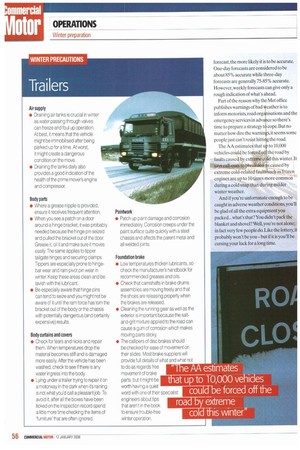Air supply
Page 56

If you've noticed an error in this article please click here to report it so we can fix it.
• Draining air tanks is crucial in winter as water passing through valves can freeze and foul up operation. At best, it means that the vehicle might be immobilised after being parked up for a time. At worst, it might create a dangerous condition on the move.
• Draining the tanks daily also provides a good indication of the health of the prime mover's engine and compressor.
Body parts
• Where a grease nipple is provided, ensure it receives frequent attention.
• When you see a patch on a door around a hinge bracket, it was probably needed because the hinge pin seized and pulled the bracket out of the door. Grease it, oil it and make sure it moves easily. The same applies to tipper tailgate hinges and securing clamps. Tippers are especially prone to hingebar wear and rain pivot pin wear in winter. Keep these areas clean and be lavish with the lubricant.
• Be especially aware that hinge pins can tend to seize and you might not be aware of it until the ram force has torn the bracket out of the body or the chassis with potentially dangerous (and certainly expensive) results.
Body curtains and covers • Check for tears and nicks and repair them. When temperatures drop the material becomes stiff and is damaged more easily. After the vehicle has been washed. check to see if there is any water ingress into the body.
• Lying under a trailer trying to repair it on a motorway in the dark when its raining is not what you'd call a pleasant job. To avoid it, after all the boxes have been ticked on the inspection record spend a little more time checking the items of 'furniture that are often ignored.
Paintwodc
• Patch up paint damage and corrosion immediately. Corrosion creeps under the paint surface quite quickly with a steel chassis and affects the parent metal and all welded joints.
Foundation brake • Low temperatures thicken lubricants, so check the manufacturer's handbook for recommended greases and oils.
• Check that camshafts in brake drums assemblies are moving freely and that the shoes are releasing properly when the brakes are released.
• Cleaning the running gear as well as the exterior is important because the saltand-grit mixture applied to the road can cause a gum of corrosion which makes moving parts sticky.
























































































































































































